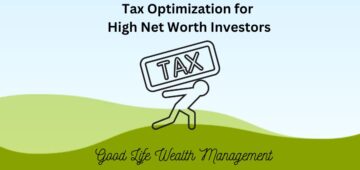For new investors, taxes are often an afterthought. Chances are good that your initial investments were in an IRA or 401(k) account that is tax deferred. If you had a “taxable” account, the gains and dividends were likely small and had a negligible impact on your income taxes. Over time, as your portfolio grows and you have more assets outside of your retirement accounts, taxes become a bigger and bigger problem. Eventually, you may find yourself paying $10,000 a year or more in taxes on your interest, dividends, and capital gains.
A high level of portfolio income may be a good problem to have, but taxes can become a real drag on the performance of your portfolio and eat up cash flow that you could use for better purposes. Luckily, there are a number of ways to reduce the taxes generated from your investment portfolio and we make this a special focus of our process at Good Life Wealth Management. We will discuss six of the ways that we work with each of our clients to create a portfolio that is tax optimized for their personal situation.
1) Maximize contributions to tax-favored accounts. While the 401(k) is the obvious starting place, investors may miss other opportunities for investing in a tax advantaged account. Since these have annual contribution limits, every year you don’t participate is a lost opportunity you cannot get back later. In addition to your 401(k) account, you may be eligible to contribute to a:
- Roth or Traditional IRA;
- SEP-IRA if you have self-employment or 1099 income;
- “Back-door” Roth IRA;
- Health Savings Account (HSA).
Also, don’t forget that investors over age 50 are eligible for a catch-up contribution to their retirement accounts. For 2014, the catch-up provision increases your maximum 401(k) contribution from $17,500 to $23,000.
2) Use tax-efficient vehicles. Actively managed mutual funds create capital gains distributions as managers buy and sell securities. These capital gains are taxable to fund shareholders, even if you just bought the fund one day before the distribution occurs. These distributions are irrelevant in a retirement account, but can be sizable when the fund is held in a taxable account.
To reduce these capital gains distributions, we use Exchange Traded Funds (ETFs) as a core component of our equity holdings. ETFs typically use passive strategies which are low-turnover and they may be able to avoid capital gains distributions altogether. It used to be difficult to estimate the after-tax returns of mutual funds, but thankfully, Morningstar now has a tool to evaluate both pre-tax and after-tax returns. Go to Morningstar.com to get a quote on your mutual fund, then click on the “Tax” tab to compare any ETF or fund to your fund. I find that even when a fund and ETF have similar pre-tax returns, the ETF often has a clear advantage when we compare after-tax returns.
One last factor to consider: many mutual funds had loss carry-forwards from 2008 and 2009. So you may not have seen a lot of capital gains distributions in the 2010-2012 time period. By 2013, however, most funds had used up their losses and resumed distributing gains, some of which were substantial.
3) Avoid Short-Term Capital Gains. Short-term gains, from positions held less than one year, are taxed as ordinary income, whereas long-term gains receive a lower tax rate of 15% (or 20% if you are in the top bracket). We try to avoid creating short-term capital gains whenever possible, and for this reason, we rebalance only once per year. We do our rebalancing on a client-by-client basis to avoid realizing short-term gains.
4) Harvest Losses Annually. From time to time, a category will have a down year. We will selectively harvest those losses and replace the position with a different ETF or mutual fund in the same category. The losses may be used to offset any gains harvested that year. Additionally, with any unused losses, you may offset $3,000 of ordinary income, and the rest will carry forward to future years.
A benefit of using the loss against other income is the tax arbitrage of the difference between capital gains and ordinary income. For example, if you pay 33% ordinary tax and 15% capital gains, using a $3,000 long-term capital loss to offset $3,000 of ordinary income is a $540 benefit ($3,000 X (.33-.15)).
5) Consider Municipal Bonds. We calculate the tax-equivalent rates of return on tax-free municipal bonds versus taxable bonds (i.e. corporate bonds, treasuries, etc.) for your income tax bracket. With the new 3.8% Medicare tax on families making over $250,000, tax-free munis are now even more attractive for investors with mid to high incomes.
6) Asset Location. This is a key step. Not to be confused with Asset Allocation, Asset Location refers to placing investments that generate interest or ordinary income into tax-deferred accounts and placing investments that do not have taxable distributions into taxable accounts. For example, we would place high yield bonds or REITs into an IRA, and place equity ETFs and municipal bonds into taxable accounts. This means that each account does not have identical holdings, so performance will vary from account to account. However, we are concerned about the performance of the entire portfolio and reducing the taxes due on your annual return.
If these six steps seem like a lot of work to reduce taxes, that may be, but for us it is second-nature to look for opportunities to help clients keep more of their hard-earned dollars. The actual benefits of our portfolio tax optimization process will vary based on your individual situation and can be difficult to predict. However, a 2010 study by Parametric Portfolio Associates calculates that a tax-managed portfolio process can improve net performance by an average of 1.25% per year.
Tax management is a valuable part of our process. And even if, today, your portfolio doesn’t generate significant taxes, I’d encourage you to think ahead. Prepare for having a large portfolio, and take the steps now to create a tax-efficient investment process.








1 Comment
Comments are closed.